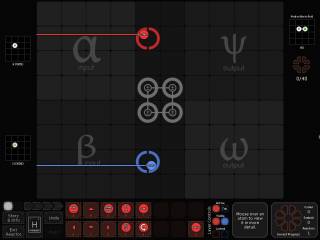Overview
SpaceChem is an indie puzzle game developed by Zachtronics Industries and distributed on the PC, Mac, and Linux for $15 via their website on January 1, 2011. It was later released for the PC and Mac on Steam (on March 2, 2011), GamersGate (on March 17, 2011), and PLAYISM (on May 11, 2011), iPad on October 1, 2011 (for $5.99) and Google Play on July 1, 2012 ($5.99). The game was also featured in the Humble Bundle for Android 3.
Players take the role of a Reactor Engineer, who must create circuits for reactors through which atoms and molecules flow (from two sets of inputs to two sets of outputs) with the aid of programmable remote manipulators (or "waldos"). Eventually, players are required to build multiple reactors and use new gameplay mechanics (such as special areas that "bond" atoms together), to create progressively more complex chemical compounds.
The Steam version contains 20 Steam achievements, friend leaderboards, and promotional material for Team Fortress 2 (in which completing exclusive missions in SpaceChem earns players crafting items in Team Fortress 2, which can be crafted into two items: a decorative pin bearing the SpaceChem logo and the Fishcake item for the Heavy). The Steam version also contains a seven-puzzle expansion DLC (for $1.99) called "SpaceChem: 63 Corvi", expanding on the story while introducing a new gameplay mechanic in the form of quantum reactors.
Gameplay
 A standard chemical reactor before instructions
A standard chemical reactor before instructionsThe core premise of SpaceChem is to take input molecules and transform them into a given output compound. This is done by programming chemical rectors with instruction sets detailing how to process its molecules. Individual instructions take the form of small labeled circles that are physically placed by the player throughout a reactor. These are linked together via a track, and processed by waldos as they are guided along the track. These tracks are then formed into a closed loop, allowing a reactor instruction set to be processed multiple times in the same manner as a "for loop" in a C/Java program allows a coded instruction set to be processed as many times as needed.
For example, a puzzle may have the player form the compound HF (hydrofluoric acid) from the inputs H (hydrogen) and F (fluoride). A solution may have waldos pass over "input" instructions, allowing H and F atoms into the reactor. "Grab" instructions can then have waldos pick up the H and F atoms, and a "Bond +" instruction will cause the two atoms to be bonded together. A "drop" instruction will then drop the constructed HF molecule at the desired output location, and finally the track can be looped back to build additional hydrogen fluoride until the desired quota is met.
As the game progresses, new gameplay mechanics are steadily introduced in the form of new instructions and reactor types. Sensor rectors and fusion reactors, for example, allow branching instruction tracks and the production of new types of atoms respectively. The player will also encounter assignments in which multiple reactors can be chained together in a pipeline, allowing the production of more advanced chemical compounds. The game also features "defense" assignments, or boss battles, in which produced chemical compounds may be used to arm and aim various makeshift weapons to defend against enemy attackers.
The game's main campaign, roughly 50 assignments in length, is broken up into several planets, each of which introduces a new gameplay mechanic and arranges its missions into a mostly linear path. The Steam version also features optional campaigns in the form of a Mostachium missions and the purchasable 63 Corvi campaign. The game also features "ResearchNet," a compilation of user-created assignments generated from built-in tools for creating custom missions.
System Requirements
PC
- Operating System: Windows XP SP3 / Vista / 7
- Processor: 2.0 GHz Processor
- RAM Memory: 1GB RAM
- Hard Disk Space: 300MB
- Video Card: frame buffer support recommended
Mac
- Operating System: OS X version Leopard 10.5.8, Snow Leopard 10.6.3, or later.
- Processor: 2.0 GHz Processor
- RAM Memory: 1GB RAM
- Graphics: frame buffer support recommended
- Hard Drive: 300MB
Android
- A resolution of at least 1280x800 is advised, alongside a screen size of above 7 inches.
External Links
Log in to comment